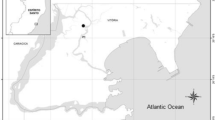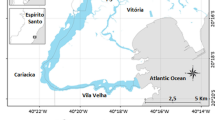Abstract
Manganese concentrations in water and sediments of the Bronkhorstspruit River, Nooitgedacht Dam and especially in the Natalspruit River, did not fall within stated limits for the protection of aquatic life. Tissue manganese concentrations in Potamonautes warreni from the Natalspruit River were generally higher than those in the tissues of crabs from the other two aquatic ecosystems. The highest mean manganese tissue concentration in crabs from the three systems was detected in the carapace (587± 445 µg g-1 wet weight). It appears that the carapace in these animals acts as a sink in which manganese can be deposited, thus also playing an important role in the detoxification of manganese in these crustaceans. No seasonal or sex-related variation was detected. Body size of the crabs, however, seems to be an important influencing factor in manganese bioaccumulation. A significant increase in carapace manganese concentrations was detected with an increase in body size. However, muscle manganese concentrations were higher in the smaller groups.
The concentration factors (BF) calculated for the different tissues with respect to the water were highest in the carapace and ranged from 280.9 to 742.8. The BF with respect to the sediment was comparatively low for all the tissues (0.1 to 0.7). As the manganese concentration in the tissues reflects to some extent the degree of manganese contamination of the surrounding aquatic environment, it appears that P. warreni may be useful as a potential biomonitor of manganese pollution.
Similar content being viewed by others
References
Alikhan, M. A., 1989. Magnesium and manganese regulation during moult cycle in Porcellio spinicomis Say (Porcellinoidae, Isopoda). Bull. envir. Contam. Toxicol. 42: 699–706.
Alikhan, M. A., G. Bagatto & S. Zia, 1990. The crayfish as a ‘biological indicator’ of aquatic contamination by heavy metals. Wat. Res. 24: 1069–1076.
Bagatto, G. & M. A. Alikhan, 1987. Copper, cadmium and nickel accumulation in crayfish populations near coppernickel smelters at Sudbury, Ontario, Canada. Bull. envir. Contam. Toxicol. 38: 540–545.
Bryan, G. W., 1976. Some aspects of heavy metal tolerance in aquatic organisms. In A. P. M. Lockwood (ed.), Effects of pollutants on aquatic organisms., Cambridge University Press, Cambridge, 193 pp.
Bryan, G. W. & E. Ward, 1965. The absorption and loss of radioactive and non-radioactive manganese by the lobster, Homarus vulgans. J. mar. biol. Ass. U.K. 45: 65–95.
Du Preez, H. H., V. E. Steenkamp & H. J. Schoonbee, 1993. Bioaccumulation of zinc and lead in selected tissues and organs of the freshwater crab, Potamonautes warreni. Sci. Tot. Envir. In press.
Du Preez, H. H. & G. J. Steyn, 1992. A preliminary investigation of the concentration of selected metals in the tissues and organs of the tigerfish (Hydrocynus vittatus) from the Olifants River, Kruger National Park, South Africa. Water S.A. 18: 131–136.
Environment Canada. 1987. Canadian Water Quality Guidelines. Report prepared by the Task Force on water quality guidelines of the Canadian Council of Resource and Environmental Ministers, 407 pp.
Förstner, U. & F. Prosi, 1979. Heavy metal pollution in freshwater ecosystems. In O. Ravera (ed.), Biological aspects of freshwater Pollution, Pergamon Press, Oxford.: 120–159.
Friberg, L., G. F. Nordberg & V. B. Vouk, 1986. Handbook on the toxicology of metals. Vol. II. Specific metals. (2nd edn). Elsevier Science Publishers, B.V. Amsterdam, 704 pp.
Gardiner, J & T. Zabel, 1989. United Kingdom water quality standards arising from European community directives — an update. Water Research Centre. Report No. PRS 2287M., 120 pp.
Greenwood, N. N. & A. Earnshaw, 1984. Chemistry of the elements. Pergamon Press, N.Y., 1542 pp.
Hart, B. T., 1974. A compilation of Australian water quality criteria. Australian Water Research Council. Technical Paper No. 7: 350 pp.
Kempster, P. L., W. A. J. Hattingh & H. R. Van Vliet, 1980. Summarized Water Quality Criteria. Department of Water Affairs, Forestry and Environmental Conservation, Pretoria. Technical Report No. Tr 108, 45 pp.
Kovacs, M., I. Nayary & L. Toth, 1984. The microelement content of some submerged and floating aquatic plants. Acta Bot. 30: 173–185.
Martin, J-L. M., 1974. Metals in Cancer irroratus (Crustacea: Decapoda): concentrations, concentration factors, discrimination factors, correlations. Mar. Biol. 28: 245–251.
Nugegoda, D. & P. S. Rainbow, 1989. Zinc uptake rate and regulation breakdown in the decapod crustacean Palaemon elegans Rathke. Ophelia. 30: 199–212.
Skidmore, J. F., 1964. Toxicity of zinc compounds to aquatic animals, with special reference to fish. The Quaterly Review of Biology. 39: 227–247.
Steenkamp, V. E., H. H. Du Preez, H. J. Schoonbee, A. J. B. Wiid & M. M. Bester, 1993. Bioaccumulation of iron in three freshwater crab (Potamonautes warreni) populations and notes on the physical-chemical parameters of the water. Water S.A. 19: 281–290.
Van Eeden, P. H., 1990. Die voorkoms en akkumulering van geselekteerde swaarmetale in die rioolbesoedelde, organies verrykte Elsburgspruit-Natalspruit vlei-ekosisteem. Unbublished M.Sc thesis, Rand Afrikaans University, P.O. Box 524, Auckland Park, 2006, South Africa, 396 pp.
Van Eeden, P. H. & H. J. Schoonbee, 1991. Bioaccumulation of heavy metals by the freshwater crab Potamonautes warreni from a polluted wetland. S. Afr. J. Wild. Res. 21: 103–107.
Van Loon, J. C., 1980. Analytical Atomic Absorption Spectroscopy. Selected Methods. Academic Press, N.Y., 337 pp.
White, S. L. & P. S. Rainbow, 1984. Zinc flux in Palaemon elegans (Crustacea:Decapoda): molting, individual variation and tissue distribution. Mar. Ecol. Prog. Ser. 19: 153–166.
Wiener, J. G. & J. P. Giesy, 1979. Concentrations of Cd, Cu, Mn, Pb and Zn in fishes in a highly organic softwater pond. J. Fish. Res. Board. Can. 35: 270–279.
Zitko, V. & W. G. Carson, 1976. A mechanism of the effects of water hardness on the lethality of heavy metals to fish. Chemosphere. 5: 299–303.
Author information
Authors and Affiliations
Rights and permissions
About this article
Cite this article
Steenkamp, V.E., du Preez, H.H., Schoonbee, H.J. et al. Bioaccumulation of manganese in selected tissues of the freshwater crab, Potamonautes warreni (Calman), from industrial and mine-polluted freshwater ecosystems. Hydrobiologia 288, 137–150 (1994). https://doi.org/10.1007/BF00006237
Received:
Revised:
Accepted:
Issue Date:
DOI: https://doi.org/10.1007/BF00006237




